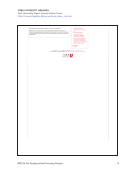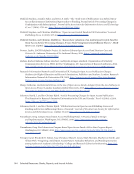8 Survey Results: Executive Summary
While a minority of responding libraries (23, or 30%) currently have APC funds, and some of
them are struggling with success and demand outweighing funding and/or administrative support, the
number of funds appears to be stable or growing slowly. The growth rate does not match the expansion of
the model among journals, or its popularity among authors, though. This is likely due to the difficulty of
shifting funding from subscriptions to APCs.
Because the theories and practices are evolving rapidly, stakeholders are monitoring trends
and opportunities. Where funds do exist, the release of detailed open APC data will enable further
research. In addition, libraries will need to gather APC data comprehensively, since central APC funds
likely account for a minority of APC spending at their institutions.
This SPEC Kit brings together information that will help institutions that are considering
funding APCs, and it documents the current APC landscape in North American research libraries
while focusing on one strategy that some ARL member institutions are using to address OA journal
funding. With this survey data and analysis, ARL and its members can better understand their place in
the evolving arena of OA, review strategies that foster public access to peer-reviewed scholarship, and
consider how these activities are transforming the university policies and practices. The survey data
document current policies and practices and how they serve the larger academic communities. The
data and analysis contribute to understanding the range of considerations for OA funding models. This
investigation can also inform the development and assessment of models of scholarly communication and
publishing. Finally, it will contribute to a better understanding of how OA funds address the expectations
and needs of university communities and how such funds support the library’s mission.
Endnotes
1 Open Access (OA) is such a common term among libraries that we did not provide the usual
definition crafted succinctly by Peter Suber. “Open-access (OA) literature is digital, online, free of
charge, and free of most copyright and licensing restrictions.” http://legacy.earlham.edu/~peters/
wfos/overview.htm
2 Rachel Radom, Melanie Feltner-Reichert, and kynita stringer-stanback, Organization of Scholarly
Communication Services, SPEC Kit 332, Washington, DC: Association of Research Libraries, 2012,
40, http://publications.arl.org/Organization-of-Scholarly-Communication-Services-SPEC-Kit-332.
3 Greg Tananbaum, North American Campus-Based Open Access Funds: A Five-Year Progress Report.
Washington, DC: SPARC, 2014, 2, http://sparcopen.org/wp-content/uploads/2016/01/OA-Fund-5-
Year-Review.pdf.
4 Kate Lara, “The Library’s Role in the Management and Funding of Open Access Publishing,”
Learned Publishing 28, no. 1 (2015): 5, http://doi.org/10.1087/20150102.
5 Danny A. Kingsley, “Paying for Publication: Issues and Challenges for Research Support Services,”
Australian Academic &Research Libraries 45, no. 4 (2014): 271, http://doi.org/10.1080/00048623.2
014.945135 Laura Waugh, Open Access Fund Research Report, Denton: University of North Texas
Libraries, 2012, 3, http://digital.library.unt.edu/ark:/67531/metadc111007/.
6 Bo-Christer Björk and David J. Solomon, Developing an Effective Market for Open Access Article
Processing Charges, London: Wellcome Trust, 2014, 23, https://wellcome.ac.uk/sites/default/files/
developing-effective-market-for-open-access-article-processing-charges-mar14.pdf.
7 Sarah Beaubien, Julie Garrison, and Doug Way, “Evaluating an Open Access Publishing Fund at a
Comprehensive University,” Journal of Librarianship and Scholarly Communication 3, no. 3 (2016): 8,
http://doi.org/10.7710/2162-3309.1204.
While a minority of responding libraries (23, or 30%) currently have APC funds, and some of
them are struggling with success and demand outweighing funding and/or administrative support, the
number of funds appears to be stable or growing slowly. The growth rate does not match the expansion of
the model among journals, or its popularity among authors, though. This is likely due to the difficulty of
shifting funding from subscriptions to APCs.
Because the theories and practices are evolving rapidly, stakeholders are monitoring trends
and opportunities. Where funds do exist, the release of detailed open APC data will enable further
research. In addition, libraries will need to gather APC data comprehensively, since central APC funds
likely account for a minority of APC spending at their institutions.
This SPEC Kit brings together information that will help institutions that are considering
funding APCs, and it documents the current APC landscape in North American research libraries
while focusing on one strategy that some ARL member institutions are using to address OA journal
funding. With this survey data and analysis, ARL and its members can better understand their place in
the evolving arena of OA, review strategies that foster public access to peer-reviewed scholarship, and
consider how these activities are transforming the university policies and practices. The survey data
document current policies and practices and how they serve the larger academic communities. The
data and analysis contribute to understanding the range of considerations for OA funding models. This
investigation can also inform the development and assessment of models of scholarly communication and
publishing. Finally, it will contribute to a better understanding of how OA funds address the expectations
and needs of university communities and how such funds support the library’s mission.
Endnotes
1 Open Access (OA) is such a common term among libraries that we did not provide the usual
definition crafted succinctly by Peter Suber. “Open-access (OA) literature is digital, online, free of
charge, and free of most copyright and licensing restrictions.” http://legacy.earlham.edu/~peters/
wfos/overview.htm
2 Rachel Radom, Melanie Feltner-Reichert, and kynita stringer-stanback, Organization of Scholarly
Communication Services, SPEC Kit 332, Washington, DC: Association of Research Libraries, 2012,
40, http://publications.arl.org/Organization-of-Scholarly-Communication-Services-SPEC-Kit-332.
3 Greg Tananbaum, North American Campus-Based Open Access Funds: A Five-Year Progress Report.
Washington, DC: SPARC, 2014, 2, http://sparcopen.org/wp-content/uploads/2016/01/OA-Fund-5-
Year-Review.pdf.
4 Kate Lara, “The Library’s Role in the Management and Funding of Open Access Publishing,”
Learned Publishing 28, no. 1 (2015): 5, http://doi.org/10.1087/20150102.
5 Danny A. Kingsley, “Paying for Publication: Issues and Challenges for Research Support Services,”
Australian Academic &Research Libraries 45, no. 4 (2014): 271, http://doi.org/10.1080/00048623.2
014.945135 Laura Waugh, Open Access Fund Research Report, Denton: University of North Texas
Libraries, 2012, 3, http://digital.library.unt.edu/ark:/67531/metadc111007/.
6 Bo-Christer Björk and David J. Solomon, Developing an Effective Market for Open Access Article
Processing Charges, London: Wellcome Trust, 2014, 23, https://wellcome.ac.uk/sites/default/files/
developing-effective-market-for-open-access-article-processing-charges-mar14.pdf.
7 Sarah Beaubien, Julie Garrison, and Doug Way, “Evaluating an Open Access Publishing Fund at a
Comprehensive University,” Journal of Librarianship and Scholarly Communication 3, no. 3 (2016): 8,
http://doi.org/10.7710/2162-3309.1204.
























































































































































